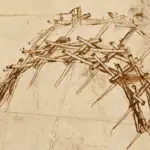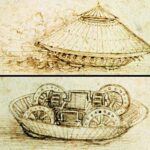Leonardo da Vinci Crossbow

Leonardo da Vinci Giant Crossbow Design
Leonardo da Vinci Crossbow captures the imagination with its blend of art and engineering.
This invention, a marvel of its time, shows Da Vinci’s genius in transforming traditional weaponry into advanced machinery.
Inspired by ancient ballistae, the giant crossbow was designed to launch large stones or possibly flaming projectiles rather than arrows.
During the late 15th century, Da Vinci’s crossbow represented a significant leap in military technology.
Its innovative crank-and-gear mechanism allowed for powerful launches while maintaining structural integrity.
His meticulous designs, preserved in the Codex Atlanticus, reveal his vision for improving both speed and efficiency in warfare.
Recreating Da Vinci’s crossbow involves understanding the intricate details of his sketches.
Modern engineers have attempted to bring his design to life by crafting models, though adjustments were needed to handle the bowstring’s tension effectively.
This blend of art and science emphasizes the depth of Da Vinci’s insight and highlights the continued relevance of his work beyond his era.
Leonardo da Vinci Crossbow: Historical Context
Leonardo da Vinci‘s ingenious mind led to numerous innovations, including his famous crossbow. Understanding his early life and the state of warfare technology at the time offers insight into his motivation and methods.
Early Life of Leonardo da Vinci
Leonardo da Vinci was born in 1452 in Vinci, Italy. His upbringing in a small town fostered a sense of curiosity and innovation.
As a young man, he apprenticed under Andrea del Verrocchio, which honed his skills in various fields such as art, mechanics, and design. This diverse training laid the groundwork for his future inventions.
Da Vinci’s natural inquisitiveness drove him to explore numerous subjects. His interest in anatomy, flight, and warfare made him a Renaissance man. His prolific work, including the Leonardo da Vinci crossbow, is a testament to his inventive prowess.
Warfare Technology in the 15th Century
Warfare experienced significant changes during the 15th century. Traditional weapons, such as swords and simple bows, were gradually replaced by more advanced artillery.
Leonardo da Vinci’s crossbow represented a push towards these new technologies.
Like the giant crossbow, Leonardo’s designs combined existing concepts with innovative mechanisms. He integrated gears and pulleys to increase firing power and accuracy, demonstrating his forward-thinking understanding of mechanical advantage and efficiency.
Leonardo da Vinci’s crossbow was part of a broader interest in his war machines. These included designs for tanks and cannons, showcasing his diverse talents and impact on military technology.
The da Vinci crossbow exemplifies the period’s transition and his significant role in advancing military engineering.
Conceptualization of the Crossbow
Leonardo da Vinci’s giant crossbow embodies innovation and engineering brilliance. It showcases his ability to blend artistic vision with mechanical precision, and it is a testament to his ingenuity and talent for designing remarkable machines.
Leonardo’s Innovative Design
Leonardo da Vinci envisioned a giant crossbow that would be both a formidable weapon and a psychological tool in warfare.
His design featured a massive frame with a wooden structure reinforced by metal. The crossbow’s size was intended to intimidate and demoralize enemies before launching any projectiles.
Leonardo’s drawings indicate a structure that could launch large missiles or stones, showing his understanding of military tactics.
His approach differed significantly from traditional crossbows. He focused on increasing range and power, effectively allowing the crossbow to strike distant targets.
Leonardo da Vinci’s emphasis on psychological impact highlights his strategic thinking and anticipates modern concepts of warfare intimidation.
Mechanical Principles
The mechanical aspects of Leonardo’s design reveal his deep knowledge of physics and engineering.
The crossbow utilized a lever and pulley system to increase tension, providing greater force when launching projectiles. This mechanism stored and released enormous energy, making it possible to hurl large objects over long distances.
His design also included meticulous details for aligning and stabilizing the massive frame during operation.
This ensured accuracy and efficiency, which were crucial for battlefield use. The fusion of these mechanical elements demonstrates da Vinci’s ability to transform complex concepts into functional devices, solidifying his legacy as a master inventor in numerous fields, including war machinery.
Design Details
Leonardo da Vinci’s crossbow, often called the giant crossbow or ballista, showcases his skills as an inventor. This design highlights his interest in creating innovative war machines.
Materials and Dimensions
The giant crossbow featured in Leonardo’s plans would have been constructed using a combination of wood, metal, and rope.
The wooden parts provided structure due to their sturdiness and flexibility. Metal components like gears and triggers added precision and strength to the design.
The dimensions of this crossbow were ambitious. It was intended to be enormous, with wheels to assist in moving the hefty machine. The size allowed it to launch large projectiles, making it an effective siege weapon.
Drawing and Sketch Analysis
Leonardo da Vinci’s technical drawings, housed in the Codex Atlanticus, provide insight into his engineering prowess.
His sketches detail the crossbow’s external structure and its intricate inner workings.
He used a worm gear mechanism to create a mechanical advantage, allowing two people to draw the mighty bow.
These drawings illustrate Leonardo da Vinci’s aptitude for blending art with science, showcasing his precision in capturing mechanical details.
His methodical approach to each component, from the wheel placement to the firing mechanism, enabled the realization of such a large crossbow. This design exemplifies his broader interest in military engineering and innovations, much like his work on the da Vinci tank and other war machines.
Comparative Significance
Leonardo da Vinci’s giant crossbow is an intriguing comparison with contemporary and future weaponry. This section examines how it fits into the weaponry of Da Vinci’s time and also reflects on its influence on later innovations.
Comparison between Contemporary vs. Da Vinci Crossbows
Influence on Future Inventions
Leonardo da Vinci’s designs, including the giant crossbow, left a significant mark on future innovations.
His technical drawings served as blueprints for inventors to explore mechanical possibilities.
The principles observed in the crossbow mechanisms, such as crank systems and gears, were precursors to future artillery systems.
In particular, the ambition of the giant crossbow foreshadowed more advanced war machines, such as the Leonardo da Vinci tank.
Involving multiple components to enhance power and accuracy influenced engineers and inventors for generations.
Leonardo da Vinci’s explorations into mechanical warfare underscore his legacy as a visionary thinker who continues to inspire today’s technological advancements.
Final Thoughts
Leonardo da Vinci’s Crossbow stands as a testament to his inventive genius and understanding of mechanics. This giant crossbow, sometimes referred to as a ballista, showcased his ability to merge art and engineering.
The design featured a complex system of gears and cranks, enabling two men to pull back the massive bowstring.
This mechanism allowed for significant power and range. The crossbow could be fired using a release catch, which made it efficient in combat scenarios.
Key Takeaways:
- The crossbow highlights Leonardo’s blend of innovation and practicality.
- His designs continue to inspire modern engineering and art.
The crossbow remains a symbol of his enduring legacy in both military and artistic fields.
Frequently Asked Questions
Leonardo da Vinci’s work on the crossbow includes innovative designs and unique features. His giant crossbow, also known as the ballista, was never built during his time but continues to intrigue historians and engineers alike.
What weapon did Leonardo da Vinci invent?
Leonardo da Vinci designed a giant crossbow, a massive weapon featured in his drawings in the Codex Atlanticus. This military invention was intended to launch large projectiles like stones. While it was never constructed during his lifetime, it reflects his brilliance in combining technology and art.
What is the purpose of the giant crossbow?
The giant crossbow was designed to hurl large projectiles over great distances. This could include stones or flaming missiles, aimed to destroy or disorient enemy forces. It demonstrates Leonardo’s understanding of warfare and mechanics.
Did Leonardo da Vinci invent the ballista?
Leonardo did not invent the ballista but redesigned it in his own innovative style. His version was meant to improve upon traditional models by using advanced mechanisms such as gearing systems. The crossbow reflects his ability to rethink and enhance existing technologies.
What person invented the crossbow?
The origin of the crossbow dates back to ancient China, centuries before Leonardo’s time. It was widely used in various cultures for hunting and warfare. Leonardo’s work involved enhancing and adapting the existing crossbow design.
What was Leonardo’s weapon?
Leonardo’s weapons include the giant crossbow and other inventions like his design for a tank. Many of these were conceptual, showcasing his deep interest in military engineering.
The crossbow, in particular, highlights his skill in combining mechanics with art.
How big was the giant crossbow?
Leonardo’s giant crossbow was meant to be enormous, with dimensions that could exceed several meters in length. It was never built during his lifetime, but models based on his drawings suggest it would have been a formidable presence on the battlefield.
Its massive size was intended to bolster its range and impact.
What instrument did Leonardo da Vinci invent?
Leonardo is not credited with inventing a new musical instrument, but he drew and conceptualized improvements for existing ones. He made designs for devices like the viola organista, a bowed keyboard instrument.
His ability to innovate extended beyond art and engineering to include musical instruments.
What military things did Leonardo da Vinci invent?
Leonardo’s military inventions included designs for tanks, machine guns, and fortifications. His concepts were often ahead of his time and displayed his engineering skills and understanding of military strategy.
Although many were not built, they have inspired generations of inventors.
How does da Vinci Catapult work?
Leonardo’s catapult design introduced a sophisticated system of gears and springs to improve tension and launch distance. This design aimed to provide more power and precision compared to traditional catapults.
It highlights his ability to improve upon existing military technology using his understanding of physics.
What was Leonardo da Vinci’s greatest accomplishment?
Leonardo’s greatest accomplishment is arguably his contribution to both art and science. Works like the Mona Lisa and The Last Supper are some of his most famous creations.
Inventions like his flying machine sketches also showcase his visionary thinking. His legacy is not confined to a single achievement but encompasses his diverse impact across multiple fields.
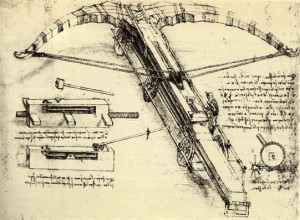
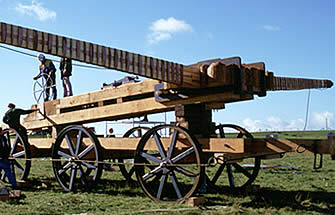
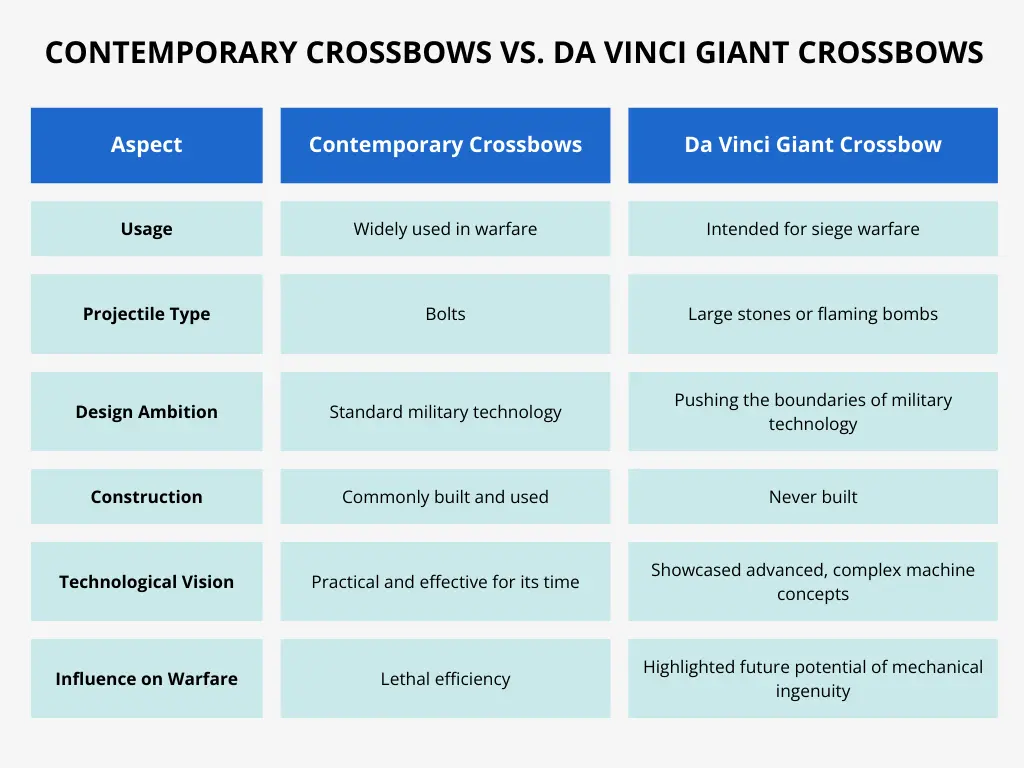
 I’m Leonardo Bianchi, the mind behind Leonardo da Vinci's Inventions. Thanks for visiting.
I’m Leonardo Bianchi, the mind behind Leonardo da Vinci's Inventions. Thanks for visiting. 